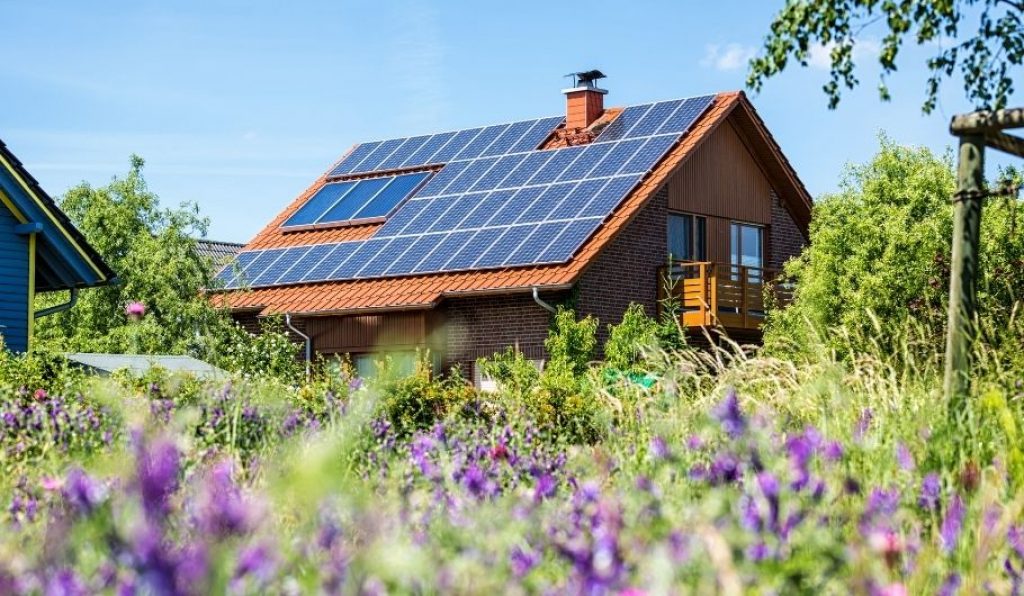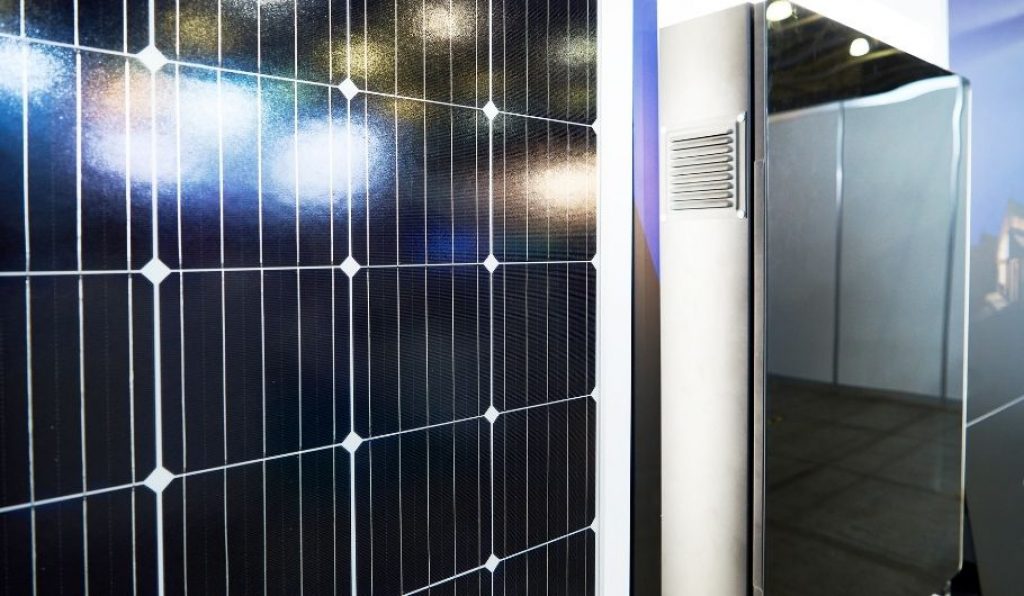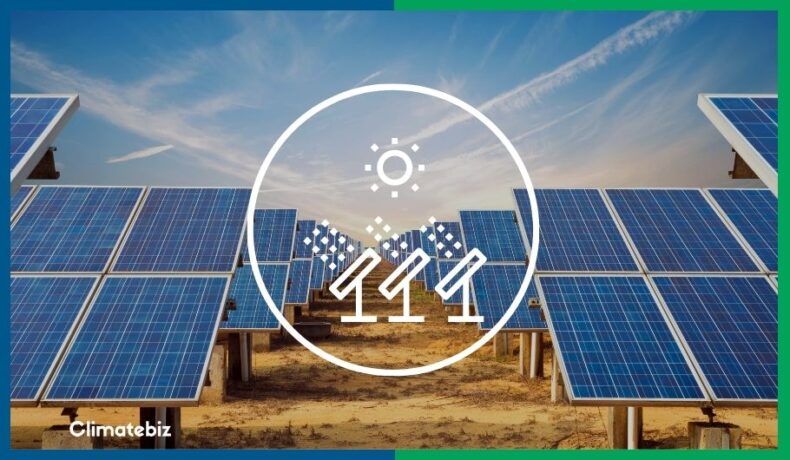50 solar panels may not be much by commercial standards. However, this amount of PV panels makes for quite a large solar system size by residential standards.
This tends to apply no matter where you stay, especially those of you living in areas with above average amounts of solar irradiation. We’re talking to you Californians!
Nevertheless, if you’re contemplating whether a photovoltaic system consisting of 50 solar panels will be enough to meet your energy needs, then keep reading.
Table of Contents
How Much Energy Will 50 Solar Panels Produce?

The energy production of a solar panel depends on 3 primary factors:
- Location
- Power rating
- Solar panel type
Location
The location of your 50 solar panels is perhaps one of the most critical factors that determine energy output potential.
You see, each regional location has varying climatic conditions. The equator is the main driving factor here as it receives more sunlight than the poles.
The more solar irradiation an area receives, the more energy per square meter (roughly 10.5 feet) can be converted into electricity by a solar panel.
In short, solar panels located in sunnier areas produce more electricity.
Power Rating
Not all solar panels are made equal. They are classed based on their nameplate capacity (official power production rating given to the equipment).
You could, for example, buy a 50-watt, 100-watt, 200-watt, 400-watt, or 500-watt solar panel if you wanted. The rule of thumb here being the higher the wattage rating, the more power output potential.
This means 50 solar panels, each rated at 500 watts, will produce much more electricity than 50 solar panels rated at 100 watts.
Solar Panel Type
Different solar panels have varying levels of energy production.
There are three main types of solar panel technologies available to mainstream consumers: polycrystalline, monocrystalline, and thin-film.
Each type of technology has varying levels of efficiency — not all of them convert sunlight into electricity at the same efficiency level.
- Polycrystalline: 13 – 16%
- Monocrystalline: 18 – 24%
- Thin-Film: 13 – 19%
Based on the above stats, it’s easy to see how 50 monocrystalline solar panels will produce more electricity than 50 polycrystalline solar panels.
So, How Much Energy Can 50 Solar Panels Produce?
The points mentioned above are the main driving factors for energy production. However, other considerations include system losses, tilt angle, and azimuth degree.
For simplicity’s sake, we won’t go into too much detail on those additional considerations. However, we’ll include them in our calculations as we need them to establish how much energy 50 solar panels can produce.
For this example, we’ll assume the following:
- Location: California
- Power rating: 400 watts
- Solar panel type: Monocrystalline
- System losses: 14.08%
- Tilt (deg): 20
- Azimuth (deg): 180
- Number of panels: 50
50 solar panels rated at 400 watts each would produce 31,787 kWh per year.
See the below table for a monthly breakdown:
| Month | Solar Radiation (kWh / m2 / day) | AC Energy (kWh) |
|---|---|---|
| January | 3.47 | 1,686 |
| February | 4.08 | 1,773 |
| March | 5.20 | 2,469 |
| April | 6.32 | 2,859 |
| May | 7.47 | 3,408 |
| June | 8.24 | 3,567 |
| July | 8.15 | 3,588 |
| August | 7.83 | 3,436 |
| September | 6.80 | 2,936 |
| October | 5.63 | 2,577 |
| November | 4.11 | 1,874 |
| December | 3.31 | 1,614 |
| Annual | 5.88 | 31,787 |
For comparison, our second example will assume the following:
- Location: Sydney, Australia
- Power rating: 200
- Solar panel type: Monocrystalline
- System losses: 14.08%
- Tilt (deg): 20
- Azimuth (deg): 180
- Number of panels: 50
50 solar panels rated at 200 watts each would produce between 14,985 kWh per year.
See the below table for a monthly breakdown:
| Month | Solar Radiation (kWh / m2 / day) | AC Energy (kWh) |
|---|---|---|
| January | 7.08 | 1,650 |
| February | 6.41 | 1,354 |
| March | 5.68 | 1,328 |
| April | 4.66 | 1,078 |
| May | 4.41 | 1,068 |
| June | 3.31 | 785 |
| July | 4.07 | 996 |
| August | 4.84 | 1,181 |
| September | 5.66 | 1,309 |
| October | 5.62 | 1,329 |
| November | 5.99 | 1,366 |
| December | 6.55 | 1,541 |
| Annual | 5.36 | 14,985 |
Lastly, we want to add a city known for getting less solar irradiation:
- Location: London, U.K.
- Power rating: 400
- Solar panel type: Monocrystalline
- System losses: 14.08%
- Tilt (deg): 20
- Azimuth (deg): 180
- Number of panels: 50
50 solar panels rated at 400 watts each would produce between 18,208 kWh per year.
See the below table for a monthly breakdown:
| Month | Solar Radiation (kWh / m2 / day) | AC Energy (kWh) |
|---|---|---|
| January | 1.08 | 553 |
| February | 1.59 | 736 |
| March | 2.45 | 1,268 |
| April | 4.07 | 1,998 |
| May | 5.15 | 2,557 |
| June | 5.03 | 2,402 |
| July | 5.22 | 2,540 |
| August | 4.76 | 2,324 |
| September | 3.44 | 1,658 |
| October | 2.26 | 1,137 |
| November | 1.31 | 647 |
| December | 0.77 | 388 |
| Annual | 3.09 | 18,208 |
As you can see, we used the exact same input for both London and California, the location being the only difference.
As a result, 50 solar panels in London produce 13,579 kWh less per year than 50 solar panels in California. Now you can truly appreciate the importance of location.
If you’d like to learn the energy production potential of your area, feel free to use our solar calculator.
How Much Power Will 50 Solar Panels Have?

This depends on the nameplate rating you decide to go with:
| Number of panels | Nameplate rating | Total power capacity |
|---|---|---|
| 50 solar panels | 50 watt | 2.5 kW |
| 50 solar panels | 100 watt | 5 kW |
| 50 solar panels | 200 watt | 10 kW |
| 50 solar panels | 300 watt | 15 kW |
| 50 solar panels | 400 watt | 20 kW |
| 50 solar panels | 500 watt | 25 kW |
| 50 solar panels | 600 watt | 30 kW |
How Much Space Do You Need For 50 Solar Panels?
The higher the nameplate rating, the larger the panel size. Below we’ve created a table for you to figure out the different space requirements based on the nameplate rating of the solar panel.
| Nameplate Rating | Size | Total Space Required For 50 panels |
|---|---|---|
| 50 watts | 2.2 ft. x 1.4 ft. | 154 ft2 |
| 100 watts | 3.9 ft. x 1.7 ft. | 331 ft2 |
| 200 watts | 4.8 ft. x 2.2 ft. | 528 ft2 |
| 400 watts | 6.5 ft. x 3.2 ft. | 1040 ft2 |
| 500 watts | 7.5 ft. x 3.7 ft. | 1387 ft2 |
| 600 watts | 8 ft. x 3.7 ft. | 1480 ft2 |
How Much Will 50 Solar Panels Cost?
You can establish the total cost by calculating the cost per watt ($/W). Once again, location means everything here, as different countries tend to have various solar incentives, which can significantly impact the overall cost of your solar system.
- United States: $2.94 per watt
- United Kingdom: £1.6 per watt
- Australia: $1.40 AUD per watt
The above prices are rough averages and do not consider various local solar incentives.
With this in mind, the total cost will also depend on the nameplate rating of your solar system.
| Country | Nameplate Rating | Total Wattage | Total Cost |
|---|---|---|---|
| United States | 200 watts | 10,000 watts | $29,400 |
| 400 watts | 20,000 watts | $58,800 | |
| 600 watts | 30,000 watts | $88,200 | |
| United Kingdom | 200 watts | 10,000 watts | £16,000 |
| 400 watts | 20,000 watts | £32,000 | |
| 600 watts | 30,000 watts | £48,000 | |
| Australia | 200 watts | 10,000 watts | $14,000 AUS |
| 400 watts | 20,000 watts | $28,000 AUS | |
| 600 watts | 30,000 watts | $42,000 AUS |
Final Thoughts
We hope we answered most of your questions, at least the important ones with this article.
If you have any more questions, feel free to reach out to us in the comments section below! Alternatively, you can visit our forum and share your opinions with us!

